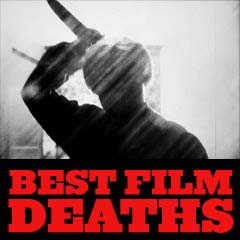
|
Deaths Scenes 1975 |
| Film Title/Year and Description | ||||||||||||||

|
The Day of the Locust (1975) Nathanael West's 1939 novel (and Waldo Salt's screenplay) upon which director John Schlesinger's drama was based, was set in Hollywood, California during its "Golden Age" of the late 1930s, when many ventured to the glittering city "in search of a dream" -
In the film's fiery, apocalyptic, and hallucinatory finale, there was a still-to-this-day shocking death. It was the stomping murder of repellent, unloved, mother-controlled 12 year-old, curly-haired child actor Adore Loomis (Jackie Earle Haley) by outraged, deeply-troubled and sexually-repressed, withdrawn accountant Homer Simpson (Donald Sutherland), a religious conservative from the Midwest. To annoyingly taunt and torment Simpson who sat on a park bench, Adore was singing: "Jeeper, Creepers," coinciding with the crowded, gala world premiere for Cecil B. DeMille's blockbuster film The Buccaneer at Grauman's Chinese Theatre in Hollywood was occurring nearby. When Simpson caught up to the boy in an alley filled with a row of parked cars, he repeatedly stomped Adore's head into the pavement (between two of the cars) until the boy perished. The boy's screams alerted the crazed mob of movie fans to see what was happening. Knowing he was confronted and caught in the act, the bewildered Simpson was surrounded and attempted to flee, but he was caught by the rioting mob, who were yelling: "Kill him!" At the film premiere, the announcer misinterpreted the nightmarish mob as enthusiastic filmgoers, and the klieg lights were directed toward the mass scuffling. Simpson was raised above the frenzied crowd, carried off and swept along in the wave of bodies. He was presumably murdered (off-screen) as his ultimate fate - bloodied and literally torn-apart in the midst of the manic rioters. After killing Homer, the crowd went on to wreak more havoc and destruction. |
  Trampling or Stomping Death  Angry Mob   Killer Homer Simpson Assaulted and Destroyed by a Crazed Mob of Film Fans |
||||||||||||

|
Death Race 2000 (1975) Director Paul Bartel's exploitative action-sport futuristic film, with political satire and nudity thrown in, was about an 'anything-goes' cross-country 'death race' in the dystopic year of 2000, with the tagline:
[Note: A franchise developed, with the remake Death Race (2008) by Paul W.S. Anderson, and two prequels, Death Race 2 (2010) and Death Race 3: Inferno (2013).] Society was ruled by a fascist, totalitarian militaristic state, led by "Mr. President" (Sandy McCallum), a cult figure. Sponsored gladitorial contests were held, including the Annual Transcontinental Road Race, a coast-to-coast race over a three-day period (this was the 20th anniversary of the contest). The main racer rivals included, among others:
Points were earned for sadistically mowing down pedestrians and bonus points were added for hitting various age groups, such as the elderly or toddlers - this accounted for frequent killings:
There was even a "Euthanasia Day" at a geriatric club/hospital, where elderly wheelchair-bound patients were positioned on the race-way as targets for the racers. Crazed fans were committed to their favorite drivers and themed sports-cars in the immoral and brutal race. The drivers - other than mowing down bystanders, were also committed to sabotaging each other's races. In a side sub-plot, Frankenstein planned to assassinate the President - the original plan to shake his hand with a grenade failed, although he was able to successfully ram the podium during the final awards ceremony and kill the political leader (seen dead on the hood of Frankenstein's car). In the next and final sequence, Frankenstein succeeded the President and then promptly abolished the race. Annoying and obnoxious announcer-reporter Junior Bruce (Don Steele) who had covered the race and objected to future races being terminated, was run over as "Mr. President Frankenstein" drove off, in the film's conclusion. |
 Frankenstein (David Carradine)  "Euthanasia Day"   One Victim Hit and Then Skull-Crushed   The Death of "Mr. President"  Junior Bruce Run Over in Conclusion |
||||||||||||
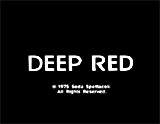
|
Deep Red/Profondo Rosso (1975, It.) (aka The Hatchet Murders) Director Dario Argento's gripping murder mystery had a scary tagline:
During the opening titles, there was a flashback to a bloody stabbing murder with a knife dropped on the floor, shown from the perspective of a child (from a low level), while an eerie child's nursery rhyme lullaby was playing. The killer's calling card became the doggerel tune. There were a number of other gruesome and bloody red murders (shot in the giallo-style by the "Italian Hitchcock") by a black raincoated figure wearing black leather gloves, including:
The most outrageous death at film's end, a major plot twist, was of the insane mother Martha (Clara Calamai) who was revealed as the film's hatchet murderer (wearing black gloves). She died when her necklace was caught in the bars of a descending elevator shaft - both strangling and decapitating her (shown in close-up in all its gory red detail).
|
  The Meat Cleaver Murder 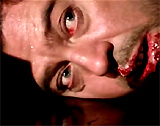  The Death of Professor Giordani - Knifed in Neck 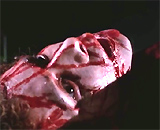  Body Dragging and Head-Squashing |
||||||||||||

|
Steven Spielberg's second-directed feature film was this realistic science-fiction suspense/horror-disaster film that tapped into the most primal of human fears - what unseen creature lurked below the dark surface of the water beyond the beach? The film's most memorable opening scene effectively answered what the menacing underwater enemy was. The terrifying sequence was underscored with the ominous, well-known, 'shark theme' - the two-note (E and F) 'da-dum' cello and bass chords of John Williams' moody, driving musical score. The opening credits were followed by a subjective camera view of an underwater creature swimming along. Shot day-for-night, it was marvelously visual in the depiction of blonde skinny-dipping Chrissie Watkins (Susan Backlinie) and her brutal, unexpected shark attack-murder. It remains the most remembered, gripping scene in the film, and was prominently displayed on the film's poster in distinctly Freudian terms (showing the ventral view of the shark's gigantic, pointed head, positioned vertically in a phallic position, with a dark mouth filled with voracious, jagged teeth). She had left the beach-party group and run toward the water, announcing teasingly that she was going swimming. Followed by a drunk male admirer who was eager for an intimate swim and casual sex, she stripped off items of clothing one-by-one as she ran further down the beach before plunging in naked. Her silhouetted image splashed at the surface, first viewed in a low-angle shot from a distance far underwater, and then from closer range. Her drunken teenage companion passed out on the shore. A metal buoy's bell on the surface of the water 'tinged' at various intervals. Her nude body was suddenly pulled under, and then dragged helplessly around (pulled this way and then that way) on the surface by the unseen shark underneath, as she screamed with blood-curdling shrieks: "God help me! God please help!" For a brief moment, she desperately grabbed the buoy and rang it for help (sounding a death knell), but was then attacked again, tugged by the below-surface invisible predator, and submerged for the last time in a horrifying sequence. The water surface was again still and deathly quiet. (see further below) |
 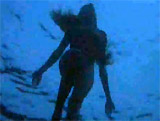    Shark Attack: "God help me!" |
||||||||||||

|
Later in the film, the shark turned its attention toward the shark-hunting vessel the Orca, rising-breaking out of the water, smashing down on the stern's transom, and capsizing the boat on its side. Both Police Chief Brody (Roy Scheider) and Quint (Robert Shaw) struggled to stay on their feet, as objects from the boat flew toward the shark. Screaming, Quint slid down the slippery deck into the open jaws of the monster Giant Great White - kicking his feet to prevent the inevitable. He was bitten in half - and blood spurted from his mouth. Quint stabbed at its eyes with a splintered piece of the deck as he was swallowed whole and devoured by the killer shark in a horrifying scene. |
  Quint's Consumption by The Great White |
||||||||||||

|
The shark itself expired with a memorable and explosive death but it took what seemed like forever to outwit the monster. Police Chief Martin Brody (Roy Scheider) heaved one of marine biologist Hooper's (Richard Dreyfuss) compressed air tank cylinders into the monster's mouth. He eyed the shark from the top mast of the sinking boat (the only part of the boat not completely underwater) as the shark swam away and then circled around for the final kill. Brody grabbed a rifle and then climbed up as high as possible on the boat's sagging mast as he prepared to shoot the explosive oxygen canister lodged in its teeth. He did little damage trying to spear the shark's head. Clinging for life, with the remnants of the boat only a few feet above the water, Brody prayed that the shark would show him the tank in its mouth in its final attack: "Show me the tank." He took aim and fired shot after shot at the oncoming shark, taunting it:
One of his last shots hit the target, violently exploding the target and causing a massive blast of shark parts. Part of the bloody shark's carcass was blown to bits all over the water surface. The rest sank in a blur of red blood and body parts to the bottom - with an accompanying deathcry. |
   The Explosive End of the Great White Shark |
||||||||||||

|
Love and Death (1975) In this Woody Allen-directed spoof of War and Peace, cowardly war hero Boris Grushenko (Woody Allen) was executed by the French military for involvement with wife Sonja (Diane Keaton) in a plot to assassinate Napoleon in Moscow. Grushenko, after being told by an angel that he would be pardoned, was cocky as he was led to his execution ("Hey, you guys are late!"), but when his pardon didn't materialize, he was shot by a firing squad (offscreen). Afterwards, widowed Sonja conversed with cousin Natasha (Jessica Harper) about love and suffering, to which Natasha replied: "I never want to marry. I just want to get divorced." Then, Sonja saw the ghost of Boris alongside a white-shrouded figure of the Grim Reaper (voice of Norman Rose) on the outdoors lawn, and asked what happened - Boris exclaimed: "I got screwed!...Some vision came and said that I was gonna get pardoned, and they shot me." He told her that death was "worse" than a local restaurant's chicken. Sonja ominously mused:
Natasha came up and asked: "Did you say 'wheat'?" Their two faces were juxtaposed into a composite (a parody of Ingmar Bergman's Persona (1966, Swe.)), and they said the word 'wheat' in unison. Boris spoke directly to the camera about how God was an underachiever:
Then behind "The End" title (before the credits rolled), jester Boris and the white-clothed Grim Reaper famously cavorted and frolicked together, dancing the mazurka next to a long row of trees in an extreme long shot, as Boris was led toward an orangish sunset and an uncertain afterlife (a parody of Bergman's The Seventh Seal (1957)). |
 The Firing Squad   Boris With Grim Reaper  Widowed Sonja  Faces Juxtaposed  Boris' Monologue About Life 
|
||||||||||||

|
The Man Who Would Be King (1975, UK) Writer/director John Huston's old-fashioned, rousing costume adventure film and morality tale, told in flashback, was based on Anglo-Indian novelist Rudyard Kipling's (Christopher Plummer) short story tale. It was about two roguish British soldiers-adventurers, Peachy Carnehan (Michael Caine) and Daniel Dravot (Sean Connery) at the turn of the century who set out from Raj-ruled India. In Kafiristan in E. Afghanistan, delusional and arrogant Daniel Dravot was pronounced king and thought by the natives to be a god - a direct descendant of Alexander the Great - when he evaded death after being struck by an arrow and was unharmed (his bandolier, leather ammunition belt, under his clothing stopped the arrow). But then when he was disappointingly revealed to be human (a marriage prospect bit him in the cheek when he kissed her during a ritualistic ceremony), and he was pursued by an angry Kafiristan mob. Wearing his crown, Dravot was trapped on a rope bridge high above a canyon's gorge. As the support ropes were hacked away, he sang a few bars of the inspirational and stirring 1812 Irish hymn by Reginald Heber: "The Son of God Goes Forth to War": ("...A glorious band, the chosen few, On whom the spirit came. While valiant saints that hope they knew, And mocked the cross and flame. He met the tyrant's brandished steel, The lion's gory mane. He bowed his head, his death to feel, (the rope bridge was cut through, sending Daniel plummeting down) -- Who followed in his train?") and then suffered a spectacular fall to his death. His decayed head was brought back (still crowned) by his surviving partner Carnehan to be viewed by Narrator/Rudyard Kipling. |
   The Spectacular Fall of Crowned King Daniel |
||||||||||||
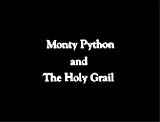
|
Monty Python and the Holy Grail (1975, UK) The zany Monty Python troupe's second film and first feature-length film was a raucous, anarchic retelling of the Middle Ages legend of King Arthur. Their style of humor was best exemplified by the comically-gruesome encounter for dueling swordplay between:
In arguably the film's most hilarious scene, the Black Knight persistently and unbelievably insisted on combat ("Tis but a scratch!") even after all of his limbs had been hacked off (first his left arm, then right arm, then right leg and left leg):
Remarkably, he didn't expire at the end of the scene, and the duel ended in a tie, even though the Black Knight was reduced to only a head and torso and asserted
|
    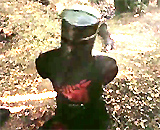 The Black Knight - Reduced to Head and Torso |
||||||||||||

|
Maverick director/producer Robert Altman's classic, multi-level, original, two and a half-hour epic study of American culture, show-business, leadership and politics - was one of the great American films of the 1970s. It was a free-form explosive tragic-comedic tale of the inter-twined (and colliding) lives of twenty-four protagonists during a five day (long weekend) period in Nashville, Tennessee (the "Athens of the South"). The concluding tragic and shocking sequence was set at a country music festival/political rally held at the Parthenon. It marked vulnerable and sacrificial country singer Barbara Jean's (Ronee Blakley) final, triumphant performance. She had just finished performing "My Idaho Home." As host Haven Hamilton (Henry Gibson) circled around her with his arms in a Victory position (with one hand grasping a bouquet of white carnations for her) and nodded toward the appreciative applause for her song, he presented the beloved, pure-spirited singer with the flowers. Suddenly, two gunshots rang out - Barbara Jean fell backwards mortally wounded (seen only at a distance), and Haven, who had selflessly tried to shield her, sprawled on top of her with a bloody gunshot wound in his upper right arm. After the arbitrary killing and panic broke out, Kenny (David Hayward) - the demented assassin in the crowd - was subdued by shocked onlookers, wrestled to the ground, and soon hauled off by state police. Ignoring his own bloody arm, Haven grabbed the microphone after the unexpected disaster and rallied the crowd to be calm by singing:
Unseen political party candidate Hal Phillip Walker's (Thomas Hal Phillips) entourage of black limousines scurried from the scene. After Haven begged for singing, he handed the microphone over to an unknown - Albuquerque (Barbara Harris). He encouraged her: "Somebody sing. Sing. Sing." Nervously at first and then more confidently, the new star rose to the occasion and rallied the crowd with her stirring, healing anthem of passivity: "It Don't Worry Me."
Their communal singing helped quell the panic - everyone mindlessly and quickly forgot the senseless, chaotic tragedy that was witnessed. |
 Barbara Jean  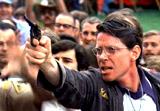  Shooting of Country Singer Barbara Jean by Kenny  "It Don't Worry Me" |
||||||||||||
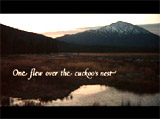
|
Director Milos Forman's Best Picture-winning drama was set in the world of an authentic mental hospital in Oregon - a place of rebellion exhibited by a energetic, flamboyant, wise-guy anti-hero against the Establishment, institutional authority and status-quo attitudes (personified by the patients' supervisory Nurse Ratched). In the film's poignant conclusion, powerful inmate Chief Bromden (Will Sampson) slowly realized that fellow patient Randall P. "Mac" McMurphy (Jack Nicholson) had mind-numbing surgery performed on his brain - probably a frontal lobotomy making him a human vegetable. Mac was subjected to the dehumanizing surgery as punishment, following his enraged attack on Nurse Ratched (Louise Fletcher). The Chief excitedly spoke to Mac about their long-standing plan to escape from the institution:
He picked up his friend's head, noting two fresh stitched scars on both sides of his upper forehead - and reacted: "Oh, no!" He lightly shook his unresponsive pal, and then realized that McMurphy had lost his vital vigor and would never be able to escape with him to Canada. He hugged his friend and promised Mac that he would be fulfilling his plan to escape:
The Chief ended McMurphy's misery to free him from the bondage of his existence in an act of mercy killing. Bromden smothered and suffocated McMurphy with a pillow - his death was symbolized by his hand going limp. Then, with his tremendous strength and inspired by McMurphy's liberating example, proving that a single person could still overcome oppressive conditions, he picked up the marble wash station from the tub room and smashed through the window with it. He escaped from the cuckoo's nest, flying away to the outer world - yet the world's horizon was both threatening and liberating. The other inmates remained incarcerated in the locked ward of the hospital after everything that had transpired. |
    Mercy Killing: Pillow Suffocation |
||||||||||||
(chronological by film title) Intro | 1915-1929 | 1930-1933 | 1934-1938 | 1939 | 1940-1942 | 1943-1945 | 1946-1947 | 1948-1949 1950-1952 | 1953-1955 | 1956-1957 | 1958-1959 1960-1961 | 1962-1963 | 1964-1966 | 1967-1968 | 1969-1970 1971 | 1972 | 1973 | 1974 | 1975 | 1976 | 1977-1978 | 1979 1980 | 1981 | 1982 | 1983 | 1984 | 1985 | 1986 | 1987 | 1987 | 1988 | 1989 1990 | 1991 | 1992 | 1993 | 1994 | 1994 | 1995 | 1995 | 1996 | 1997 | 1998 | 1998 | 1999 2000-2001 | 2002 | 2003 | 2004 | 2005 | 2006 | 2007 | 2008 | 2009 | 2010 | 2011 |